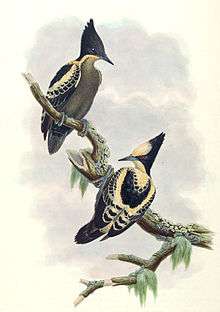Heart-spotted woodpecker
| Heart-spotted woodpecker | |
|---|---|
.jpg) | |
| Male | |
| Scientific classification | |
| Kingdom: | Animalia |
| Phylum: | Chordata |
| Class: | Aves |
| Order: | Piciformes |
| Family: | Picidae |
| Genus: | Hemicircus |
| Species: | H. canente |
| Binomial name | |
| Hemicircus canente (Lesson, 1830) | |
| Synonyms | |
|
Hemicercus cordatus | |
The heart-spotted woodpecker (Hemicircus canente) is a species of bird in the woodpecker family. They have a contrasting black and white pattern, a distinctively stubby body with a large wedge-shaped head making them easy to identify while their frequent calling make them easy to detect as they forage for invertebrates under the bark of the slender outer branches of trees. They move about in pairs or small groups and are often found in mixed-species foraging flocks. They have a wide distribution across Asia with populations in the forests of southwestern and central India which are slightly separated from their ranges in the Himalayas and Southeast Asia.
Description
.jpg)
A small, uniquely shaped, black and buff woodpecker with a large crest making the head look large for the short body and tail. Both males and females are predominantly black with heart-shaped black spots on white shoulders with broad white scapular patches and barring of flight feathers. The female has the forehead and crown buffy white while it is black on males. The throat is whitish and the underparts are dark olive grey. A tuft of feathers on the back are specialized and are lipid rich which causes the feathers to stick together in preserved specimens.[2][3] These special feathers or "fat quills" sometimes make the rump feathers appear buff and may be a form of "cosmetic colouration" and the secretion is said to have a pleasant smell but the functional significance is unknown.[4][5][6][7]
Habitat and distribution
Its natural habitat is subtropical or tropical moist lowland forests. They are found in the Himalayan forests of India, and extend into Bangladesh, Myanmar, Thailand, Laos, Cambodia and Vietnam. Within India, they are also found in the Western Ghats and the forests of central India.[8] A subspecies cordatus based on the description by Thomas C. Jerdon from a specimen from the Western Ghats is not considered distinct and the populations differ slightly in plumage colour and vary clinally in size (the northern birds being larger than those closer to the equator).[5][9][10]
Behaviour and ecology

These woodpeckers forage in pairs, sometimes joining mixed-species foraging flocks. They fly from tree to tree in a sharply bounding flight giving a head-heavy appearance. They forage on thin branches and call often. They feed mainly on insects under bark but have been known to peck the pods of Cassia fistula to obtain insect larvae.[11] The calls include a sharp twee-twee-twee (duet call) sometimes leading to a trill of several notes,[12] a nasal ki-yeew[13] and repeated su-sie calls.[14] They drum infrequently during the breeding season, mainly during winter and before the Monsoons. The nest is bored in a dead branch with a narrow 3 to 4 cm diameter opening and the tunnel going down obliquely about 20 cm before widening into a chamber. Nests may sometimes be built in fence posts.[15] The usual clutch is 2 or 3 eggs, which are unmarked white.[5] Ticks of the species Haemaphysalis spinigera have been noted on these birds.[16]
References
- ↑ BirdLife International (2012). "Hemicircus canente". IUCN Red List of Threatened Species. Version 2013.2. International Union for Conservation of Nature. Retrieved 26 November 2013.
- ↑ Bock, WJ; LL Short Jr (1971). ""Resin secretion" in Hemicircus (Picidae)". Ibis. 113 (2): 234–238. doi:10.1111/j.1474-919X.1971.tb05149.x.
- ↑ Menon GK; J Menon (2000). "Avian Epidermal Lipids: Functional Considerations and Relationship to Feathering". Am. Zool. 40 (4): 540–552. doi:10.1093/icb/40.4.540.
- ↑ Delhey, K; A Peters; B Kempenaers (2007). "Cosmetic Coloration in Birds: Occurrence, Function, and Evolution" (PDF). American Naturalist. 169: S145–S158. PMID 19426089. doi:10.1086/510095.
- 1 2 3 Ali, S; SD Ripley (1983). Handbook of the birds of India and Pakistan. Volume 4 (2nd ed.). Oxford University Press. pp. 236–237.
- ↑ Blanford WT (1895). The Fauna of British India, Including Ceylon and Burma. Birds. Volume 3. Taylor and Francis, London. pp. 68–70.
- ↑ Hargitt, E (1884). "Notes on woodpeckers VIII. The genus Hemicircus". Ibis. 26 (3): 244–259. doi:10.1111/j.1474-919X.1884.tb01163.x.
- ↑ Kanoje, R (1995). "Heartspotted Woodpecker in the Kanha National Park". Newsletter for Birdwatchers. 35 (5): 96.
- ↑ Ali,S (1951). "The Heart-spotted Woodpecker - Hemicircus canente". J. Bombay Nat. Hist. Soc. 49 (4): 786–787.
- ↑ Jerdon,T C (1840). "Catalogue of the birds of the peninsula of India". Madras Jour. Lit. Sc. 11 (27): 209–239.
- ↑ Santharam,V (1998). "Woodpeckers feeding of Cassia pods". J. Bombay Nat. Hist. Soc. 95 (3): 505–506.
- ↑ Betts, FN (1934). "South Indian woodpeckers". J. Bombay Nat. Hist. Soc. 37: 197–203.
- ↑ Rasmussen PC; JC Anderton (2005). Birds of South Asia: The Ripley Guide. Volume 2. Smithsonian Institution & Lynx Edicions. p. 291.
- ↑ Santharam, V. (2004). "Duetting calls of the Heart-spotted Woodpeckers Hemicircus canente (Lesson)". J. Bombay Nat. Hist. Soc. 101 (1): 157–158.
- ↑ Inglis, Charles M (1931). "The nesting of the Malabar Heart-spotted Woodpecker (Hemicircus canante cordatus) in Travancore". J. Bombay Nat. Hist. Soc. 35 (1): 207–208.
- ↑ Rajagopalan,PK (1972). "Ixodid Ticks (Acarina: Ixodidae) parasitizing wild birds in the Kyasanur forest disease area of Shimoga District, Mysore State, India". J. Bombay Nat. Hist. Soc. 69 (1): 55–78.
Other sources
- Menon,GK (1985): On the source of 'resin' in the plumage of heart spotted woodpecker, Hemicircus canente. Pavo 23(1&2), 107-109.
- Neelakantan,KK (1965): The nesting of the Heartspotted Woodpecker. Newsletter for Birdwatchers . 5(3), 6-8.
